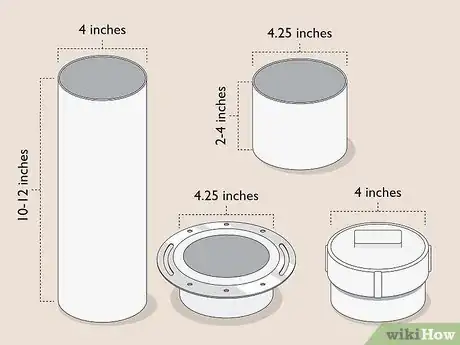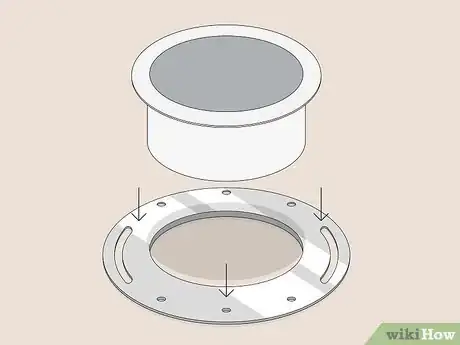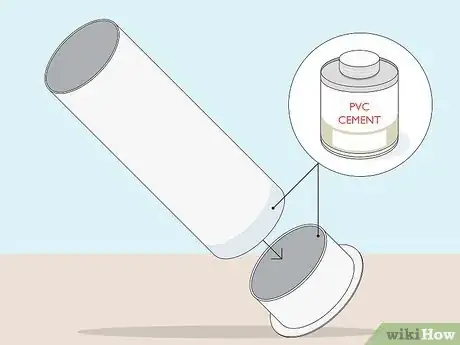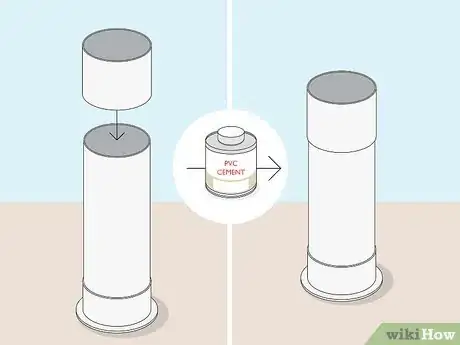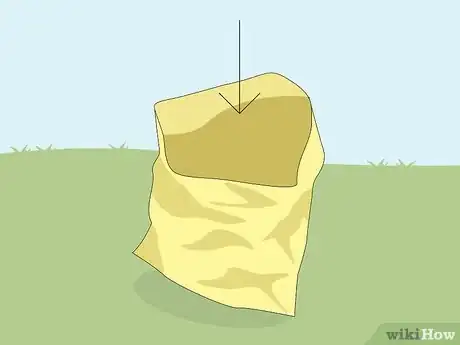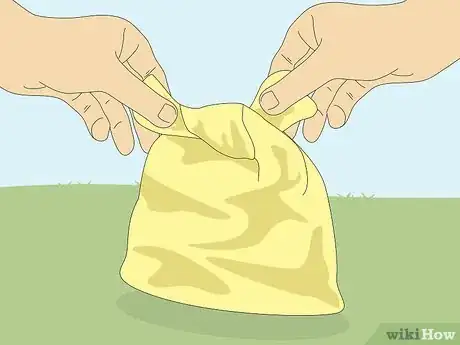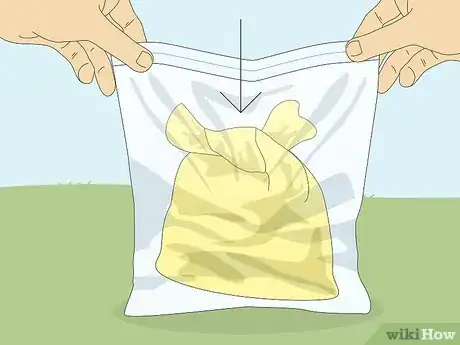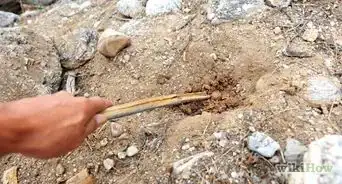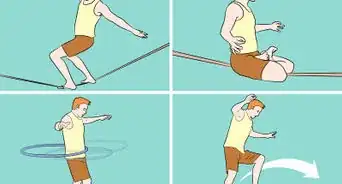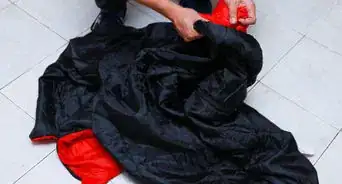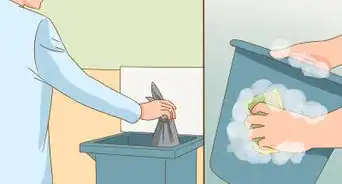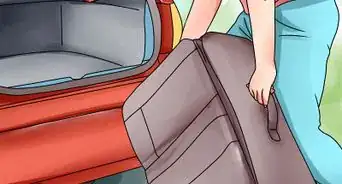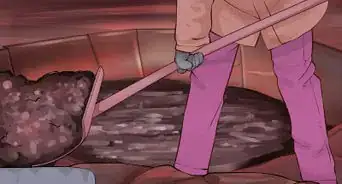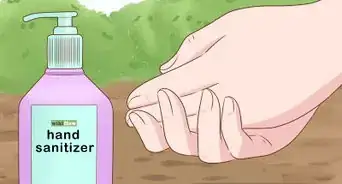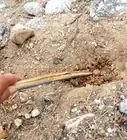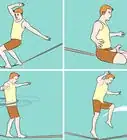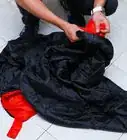This article was co-authored by wikiHow staff writer, Eric McClure. Eric McClure is an editing fellow at wikiHow where he has been editing, researching, and creating content since 2019. A former educator and poet, his work has appeared in Carcinogenic Poetry, Shot Glass Journal, Prairie Margins, and The Rusty Nail. His digital chapbook, The Internet, was also published in TL;DR Magazine. He was the winner of the Paul Carroll award for outstanding achievement in creative writing in 2014, and he was a featured reader at the Poetry Foundation’s Open Door Reading Series in 2015. Eric holds a BA in English from the University of Illinois at Chicago, and an MEd in secondary education from DePaul University.
This article has been viewed 404,077 times.
Learn more...
Freely defecating outdoors is not only bad for the environment, but it’s also illegal. While the name may seem a little silly, a poop tube is a great way to responsibly manage human waste when you’re rock climbing, hiking, or camping. To make a poop tube, use PVC piping to construct an airtight tube that is at least 4 inches (10 cm) in diameter and 10 inches (25 cm) in length. Do your business into a paper towel, coffee filter, or plastic bag. Pack your bag or paper product into a sealable plastic bag along with some cat litter or powder detergent. Then, store your waste in the poop tube until you have an opportunity to safely dispose of it.
Steps
Constructing a Poop Tube
-
1Get a PVC pipe, coupler, cleanout, plug, and toilet flange. To make a poop tube from scratch, get a length of PVC piping at least 4 inches (10 cm) in diameter and 10–12 inches (25–30 cm) long. Then, get a PVC coupler that is roughly 4.25 inches (10.8 cm) in diameter and 2–4 inches (5.1–10.2 cm) in length. You’ll also need a 4 in (10 cm) PVC cleanout and plug. Finally, buy a PVC toilet flange that is 4.25 in (10.8 cm) in diameter. Purchase some PVC cement while you’re at the store to make things easy.[1]
- A PVC pipe is a length of white plastic that doesn’t have any threading on the ends. It is used in water and sewage lines and is typically joined to other pipes using a coupler or adapter.
- Despite its name, a PVC cleanout and plug is sold as one piece. It has a cap on the end of a threaded material and is usually used to close off plumbing pipes and water lines.
- The coupler may be labelled as 4 inches (10 cm), but it’s usually around 4.25 inches (10.8 cm) in diameter. Couplers are designed to join PVC pipes of the same size together, thus the difference in the diameter. The same goes for the toilet flange.
- The toilet flange is a length of PVC used to connect a toilet to a drain line. It has a thread on one end and a cap. Make sure that your toilet flange doesn’t have screw holes in it. The openings have to be embedded in a metal rim around it for this piece to work.
-
2Remove the metal collar on the toilet flange with a mallet. Set your toilet flange on a hard surface and grab a mallet. Brace the flange on the side with your non-dominant hand to keep it still. Strike the metal collar on the opposite side to knock it loose. Once the collar is separated from the PVC pipe, slide it off the end and discard it.[2]
- You can use a hammer or the back of a wrench to strike the collar off if you don’t have a mallet.
Advertisement -
3Connect the longer tube to the flange with PVC cement. Turn the collar upside down in your hand so that the end where the rim used to be is in your palm. Open a bottle of PVC cement and use the built-in brush to coat the interior of the flange and the exterior side of the tube. Then, slide the long tube into the flange so that the 2 layers of cement meet. Push the pieces together so that the top of the flange and the top of the tube are flush.[3]
- The flange should be on the outside of the tube.
- This is the bottom of your tube. Twist the cap into the threading at the end of this piece to seal it. If you want to permanently shut this end, add PVC cement to the threading before twisting it closed. Many people prefer to leave an opening at both ends to make cleaning easier, though.
- Do not use PVC glue instead of PVC cement. While many people think that they’re the same thing, PVC cement actually binds PVC pieces together. Glue simply keeps them in place, which is usually good enough for a closed piping system but won’t work for a poop tube.
-
4Attach the coupler to the tube on the opposite end. Take your coupler and pick it up in your non-dominant hand. Then, brush PVC cement along the interior of the coupler. Add cement to the exterior of your tube on the opposite side of the flange. Slide the coupler over the tube until the tube is in the middle of the coupler.[4]
- This is the top of your poop tube. There needs to be a little bit of space at the top for your cap, so don’t make these 2 pieces flush.
-
5Glue the coupler to the cleanout and plug to add your cap. To finish, brush PVC cement around the interior section of your coupler that sticks up past the longer PVC pipe it is connected to. Then, add PVC cement to the exterior of the cleanout and plug, just beneath the rim of the cap where it sticks out. Slide the cleanout and plug inside of the coupler with the cap facing up and push the cleanout and plug down until it connects with the longer tube inside of the coupler. Wait at least 12 hours for the PVC cement to fully settle.[5]
- When you want to open or close your tube, simply twist the cap off.
Tip: You can use silicone caulk to seal the seams where the individual pieces meet if you want to prevent leaking, but the PVC cement should be more than enough to seal the tube.
Using the Tube
-
1Poop on a paper towel or inside of a plastic bag. People rarely go directly into the poop tube. Instead, poop directly onto a paper product if you’re on the ground or a plastic bag if you’re rock climbing. To have a bowel movement on a paper product, lay it out flat on the ground and squat over it. To go into a plastic bag when you’re climbing, hold the handles of the plastic bag and spread it out underneath you.[6]
- Many people opt to use coffee filters. The advantage of coffee filters is that they have a built-in lip around the edges which makes them easy to fold up. The disadvantage is that they’re pretty thin and small when compared to other options.
- Some outdoor enthusiasts prefer paper towels. Paper towels are good because you can rip off as many pieces as you need. The downside is that paper towels are a little harder to carry and can blow away in the wind.
- If you’re using plastic bags, make sure that you inspect each bag for holes before packing them in your backpack.
-
2Fold your paper product over or close the plastic bag. If you’ve pooped on a paper product, lift each corner of the paper and bring it over the center of the paper. Pinch the corners together to lift the paper up. If you’ve taken your bowel movement over a plastic bag, raise the handles out in front of you and tie the handles together in a simple knot.[7]
- If you want to ensure that your hands stay clean, pack some disposable rubber gloves in your hiking or climbing gear. Put them on before you use the poop tube and throw them in with your waste when you’re done.
-
3Stick the paper or plastic inside a sealable airtight bag. Next, grab a large, sealable plastic bag—a heavy-duty freezer bag or food storage bag will work well. Open it and spread the opening out wide. Carefully drop your plastic bag or paper product into the bag.[8]
- If you’re up in the air during a long climb, use your non-dominant hand to hold the airtight bag open in your lap while you guide the dirty plastic bag into it.
Tip: Before you go out camping, hiking, or climbing, preload the airtight bags with 2-3 small scoops of kitty litter or powder detergent to remove moisture. This will also keep obnoxious odors from leaking out of your poop tube.
-
4Seal your bag and stick it inside of your poop tube. With your poop inside the airtight plastic bag, seal it while gently forcing air out through the top of the bag. Then, gently roll the plastic bag up and open your poop tube. Slide the bag into the poop tube on its side and close the cap tight to finish using your poop tube.[9]
- Clean your poop tube thoroughly after every use. Once you’ve thrown away your used bags, clean the tube with warm water, soap, and a washcloth. Let the tube air dry outside and wash your hands with soap and water.
Warnings
- Never urinate in the tube. This will weigh the tube down and the pressure may cause a leak.⧼thumbs_response⧽
- You can use a prefabricated food-storage container if you want a simple poop tube, but they aren’t airtight and the walls aren’t very thick. If the container gets damaged, you may release some unpleasant aromas and fecal matter.[12]⧼thumbs_response⧽
- Many national parks and popular climbing sites require the use of a poop tube. If you are found defecating in the open, you may be fined.[13]⧼thumbs_response⧽
Things You’ll Need
Constructing a Poop Tube
- PVC pipe
- PVC coupler
- PVC plug
- PVC flange
- Mallet
- PVC cement
Using the Tube
- Paper towels, coffee filters, or plastic bags
- Airtight food storage bags
- Cat litter or powder detergent (optional)
- Rubber gloves (optional)
References
- ↑ https://www.trailspace.com/articles/backcountry-waste-disposal.html
- ↑ https://lnt.org/poop-tube-101/
- ↑ https://lnt.org/poop-tube-101/
- ↑ https://lnt.org/poop-tube-101/
- ↑ http://www.houstoncanoeclub.org/content.aspx?page_id=22&club_id=496051&module_id=234326
- ↑ https://gripped.com/routes/three-ways-to-deal-with-poop-and-rock-climbing/
- ↑ http://www.houstoncanoeclub.org/content.aspx?page_id=22&club_id=496051&module_id=234326
- ↑ http://www.houstoncanoeclub.org/content.aspx?page_id=22&club_id=496051&module_id=234326
- ↑ https://www.accessfund.org/open-gate-blog/poop-waste-disposal-strategies-for-climbers
- ↑ https://www.accessfund.org/open-gate-blog/poop-waste-disposal-strategies-for-climbers
- ↑ https://www.accessfund.org/open-gate-blog/poop-waste-disposal-strategies-for-climbers
- ↑ https://gripped.com/routes/three-ways-to-deal-with-poop-and-rock-climbing/
- ↑ https://www.theverge.com/2018/3/8/17093206/denali-national-park-human-waste-regulations-clean-mountain-can-e-coli
About This Article
A poop tube is a great way to manage your waste when you’re in nature. You can save money and make your own tube from a PVC pipe, coupler, cleanout and plug, toilet flange, and PVC cement. You’ll need to remove the metal collar of the toilet flange with a mallet, connect the longer tube to the flange with PVC cement, attach the coupler to the opposite end, and glue the coupler to the cleanout and plug. Wait at least 12 hours for the cement to set before you use your tube. When you’re away from a toilet, just poop on a paper towel or plastic bag, wrap it in a sealable bag, and seal it inside your poop tube. For more tips, including how to coat the inside of your poop tube to help seal the smell inside, read on.
